Response of Soil Moisture to Precipitation at Different Smash-Ridging Tillage Depths in Typical Sugarcane Fields in Guangxi, China
Abstract
1. Introduction
2. Materials and Method
2.1. Experiment Area
2.2. Experiment Design and Field Management
2.3. Data Processing and Analysis
2.3.1. Coefficient of Variation of Soil Moisture
2.3.2. Wavelet Coherency Analysis
2.3.3. Soil Moisture Replenishment
3. Results
3.1. Soil Physical and Chemical Properties
3.2. Dynamic Variations in Soil Moisture Content
3.3. Vertical Exchange Trend of Soil Moisture
3.3.1. Wavelet Correlation of Soil Moisture at Different Depths
3.3.2. Variation in Vertical Exchange of Soil Moisture
3.4. Response of Soil Moisture Content to Different Precipitation
3.4.1. Response of Soil Moisture to Light Rain
3.4.2. Response of Soil Moisture to Moderate Rain
3.4.3. Response of Soil Moisture to Heavy Rain
3.4.4. Response of Soil Moisture to Torrential Rain
3.5. Response of Soil Moisture Replenishment Characteristics to Precipitation
3.6. Correlation Analysis of Soil Parameters
4. Discussion
5. Conclusions
Author Contributions
Funding
Data Availability Statement
Acknowledgments
Conflicts of Interest
References
- Lin, H.; Bouma, J.; Wilding, L.P.; Richardson, J.L.; Kutílek, M.; Nielsen, D.R. Advances in Hydropedology. In Advances in Agronomy; Elsevier: Amsterdam, The Netherlands, 2005; Volume 85, pp. 1–89. ISBN 978-0-12-000783-7. [Google Scholar]
- Peng, F.; Mu, M.; Sun, G. Responses of Soil Moisture to Climate Change Based on Projections by the End of the 21st Century under the High Emission Scenario in the ‘Huang–Huai–Hai Plain’ Region of China. J. Hydro-Environ. Res. 2017, 14, 105–118. [Google Scholar] [CrossRef]
- Vereecken, H.; Kamai, T.; Harter, T.; Kasteel, R.; Hopmans, J.; Vanderborght, J. Explaining Soil Moisture Variability as a Function of Mean Soil Moisture: A Stochastic Unsaturated Flow Perspective. Geophys. Res. Lett. 2007, 34, 2007GL031813. [Google Scholar] [CrossRef]
- Yang, L.; Chen, L.; Wei, W.; Yu, Y.; Zhang, H. Comparison of Deep Soil Moisture in Two Re-Vegetation Watersheds in Semi-Arid Regions. J. Hydrol. 2014, 513, 314–321. [Google Scholar] [CrossRef]
- Zucco, G.; Brocca, L.; Moramarco, T.; Morbidelli, R. Influence of Land Use on Soil Moisture Spatial–Temporal Variability and Monitoring. J. Hydrol. 2014, 516, 193–199. [Google Scholar] [CrossRef]
- Daly, E.; Porporato, A. A Review of Soil Moisture Dynamics: From Rainfall Infiltration to Ecosystem Response. Environ. Eng. Sci. 2005, 22, 9–24. [Google Scholar] [CrossRef]
- Heathman, G.C.; Larose, M.; Cosh, M.H.; Bindlish, R. Surface and Profile Soil Moisture Spatio-Temporal Analysis during an Excessive Rainfall Period in the Southern Great Plains, USA. Catena 2009, 78, 159–169. [Google Scholar] [CrossRef]
- Oki, T.; Kanae, S. Global Hydrological Cycles and World Water Resources. Science 2006, 313, 1068–1072. [Google Scholar] [CrossRef]
- Chaney, N.W.; Roundy, J.K.; Herrera-Estrada, J.E.; Wood, E.F. High-Resolution Modeling of the Spatial Heterogeneity of Soil Moisture: Applications in Network Design. Water Resour. Res. 2015, 51, 619–638. [Google Scholar] [CrossRef]
- Vereecken, H.; Pachepsky, Y.; Simmer, C.; Rihani, J.; Kunoth, A.; Korres, W.; Graf, A.; Franssen, H.J.-H.; Thiele-Eich, I.; Shao, Y. On the Role of Patterns in Understanding the Functioning of Soil-Vegetation-Atmosphere Systems. J. Hydrol. 2016, 542, 63–86. [Google Scholar] [CrossRef]
- He, Z.; Zhao, W.; Liu, H.; Chang, X. The Response of Soil Moisture to Rainfall Event Size in Subalpine Grassland and Meadows in a Semi-Arid Mountain Range: A Case Study in Northwestern China’s Qilian Mountains. J. Hydrol. 2012, 420–421, 183–190. [Google Scholar] [CrossRef]
- A, Y.; Wang, G.; Sun, W.; Xue, B.; Kiem, A. Stratification Response of Soil Water Content during Rainfall Events under Different Rainfall Patterns. Hydrol. Process. 2018, 32, 3128–3139. [Google Scholar] [CrossRef]
- Reynolds, J.F.; Kemp, P.R.; Ogle, K.; Fernández, R.J. Modifying the ‘Pulse–Reserve’ Paradigm for Deserts of North America: Precipitation Pulses, Soil Water, and Plant Responses. Oecologia 2004, 141, 194–210. [Google Scholar] [CrossRef] [PubMed]
- Singh, N.K.; Emanuel, R.E.; McGlynn, B.L.; Miniat, C.F. Soil Moisture Responses to Rainfall: Implications for Runoff Generation. Water Resour. Res. 2021, 57, e2020WR028827. [Google Scholar] [CrossRef]
- Thomey, M.L.; Collins, S.L.; Vargas, R.; Johnson, J.E.; Brown, R.F.; Natvig, D.O.; Friggens, M.T. Effect of Precipitation Variability on Net Primary Production and Soil Respiration in a Chihuahuan Desert Grassland: Precipitation variability in desert grassland. Glob. Chang. Biol. 2011, 17, 1505–1515. [Google Scholar] [CrossRef]
- Jin, Z.; Guo, L.; Lin, H.; Wang, Y.; Yu, Y.; Chu, G.; Zhang, J. Soil Moisture Response to Rainfall on the Chinese Loess Plateau after a Long-term Vegetation Rehabilitation. Hydrol. Process. 2018, 32, 1738–1754. [Google Scholar] [CrossRef]
- Barbeta, A.; Mejía-Chang, M.; Ogaya, R.; Voltas, J.; Dawson, T.E.; Peñuelas, J. The Combined Effects of a Long-term Experimental Drought and an Extreme Drought on the Use of Plant-water Sources in a Mediterranean Forest. Glob. Chang. Biol. 2015, 21, 1213–1225. [Google Scholar] [CrossRef]
- Liu, H.; Lei, T.W.; Zhao, J.; Yuan, C.P.; Fan, Y.T.; Qu, L.Q. Effects of Rainfall Intensity and Antecedent Soil Water Content on Soil Infiltrability under Rainfall Conditions Using the Run Off-on-out Method. J. Hydrol. 2011, 396, 24–32. [Google Scholar] [CrossRef]
- Heisler-White, J.L.; Knapp, A.K.; Kelly, E.F. Increasing Precipitation Event Size Increases Aboveground Net Primary Productivity in a Semi-Arid Grassland. Oecologia 2008, 158, 129–140. [Google Scholar] [CrossRef]
- Berhe, F.T.; Fanta, A.; Alamirew, T.; Melesse, A.M. The Effect of Tillage Practices on Grain Yield and Water Use Efficiency. CATENA 2013, 100, 128–138. [Google Scholar] [CrossRef]
- Huang, G.; Chai, Q.; Feng, F.; Yu, A. Effects of Different Tillage Systems on Soil Properties, Root Growth, Grain Yield, and Water Use Efficiency of Winter Wheat (Triticum aestivum L.) in Arid Northwest China. J. Integr. Agric. 2012, 11, 1286–1296. [Google Scholar] [CrossRef]
- Šíp, V.; Vavera, R.; Chrpová, J.; Kusá, H.; Růžek, P. Winter Wheat Yield and Quality Related to Tillage Practice, Input Level and Environmental Conditions. Soil Tillage Res. 2013, 132, 77–85. [Google Scholar] [CrossRef]
- Sun, M.; Ren, A.; Gao, Z.; Wang, P.; Mo, F.; Xue, L.; Lei, M. Long-Term Evaluation of Tillage Methods in Fallow Season for Soil Water Storage, Wheat Yield and Water Use Efficiency in Semiarid Southeast of the Loess Plateau. Field Crop. Res. 2018, 218, 24–32. [Google Scholar] [CrossRef]
- Yankov, P.; Drumeva, M. Effect of Different Types of Soil Tillage for Sunflower on Some Soil Physical Characteristics. Part I: Soil Moisture. Helia 2021, 44, 59–72. [Google Scholar] [CrossRef]
- Czyż, E. Effects of Cultivation of Maize (Zea mays L.) in Monoculture and Crop Rotation on Some Soil Physical Properties. Soil Sci. Ann. 2011, 62, 12–24. [Google Scholar]
- Kwaad, F.J.P.M.; Van Mulligen, E.J. Cropping System Effects of Maize on Infiltration, Runoff and Erosion on Loess Soils in South-Limbourg (The Netherlands): A Comparison of Two Rainfall Events. Soil Technol. 1991, 4, 281–295. [Google Scholar] [CrossRef]
- Aixia, R.; Weifeng, Z.; Anwar, S.; Wen, L.; Pengcheng, D.; Ruixuan, H.; Peiru, W.; Rong, Z.; Jin, T.; Zhiqiang, G.; et al. Effects of Tillage and Seasonal Variation of Rainfall on Soil Water Content and Root Growth Distribution of Winter Wheat under Rainfed Conditions of the Loess Plateau, China. Agric. Water Manag. 2022, 268, 107533. [Google Scholar] [CrossRef]
- Yin, J.D.; Zhang, X.C.; Ma, Y.F.; Yu, X.F.; Hou, H.Z.; Wang, H.L.; Fang, Y.J. Vertical Rotary Sub-Soiling under Ridge–Furrow with Plastic Mulching System Increased Crops Yield by Efficient Use of Deep Soil Moisture and Rainfall. Agric. Water Manag. 2022, 271, 107767. [Google Scholar] [CrossRef]
- Chen, D.; Huang, Y.; Shen, D.; Zhou, W.; Ao, J.; Jiang, Y.; Huang, Z.; Munir, H.; Fahd, R. Effects of Seaweed Extracts on Promoting Growth and Improving Stress Resistance in Sugarcane. Asian Agric. Res 2019, 11, 69–76. [Google Scholar] [CrossRef]
- Wei, B.H.; Gan, X.Q.; Shen, Z.Y.; Ning, X.C.; Lu, L.Y.; Wei, G.P.; Li, Y.Y.; Hu, B.; Liu, B.; Wu, Y.Y. Yield Increase of Smash-Ridging Cultivation of Sugarcane. Sci. Agric. Sin. 2011, 44, 4544–4550. (In Chinese) [Google Scholar] [CrossRef]
- Wei, B.H.; Sheng, Z.Y.; Gan, X.Q.; Liu, B.; Lu, L.Y.; Hu, P.; Li, Y.Y.; Wu, Y.Y. Effects of fenlong cultivation on yield and quality of dryland crops. J. Agric. Sci. Technol. 2012, 14, 101–105. (In Chinese) [Google Scholar] [CrossRef]
- He, J.Y.; Shi, W.Y.; Liu, F.Y.; Ma, Q.M.; Yang, Y.; Yang, J.H.; Cui, X.W.; Chen, Y.Y. Effects of Fenlong cultivation on soil key physical properties in arid areas. Agric. Res. Arid Areas 2023, 41, 195–201+228. [Google Scholar]
- Zhang, J.; Li, F.; Liao, P.; Khan, A.; Hussain, I.; Iqbal, A.; Ali, I.; Wei, B.; Jiang, L. Smash Ridge Tillage Strongly Influence Soil Functionality, Physiology and Rice Yield. Saudi J. Biol. Sci. 2021, 28, 1297–1307. [Google Scholar] [CrossRef] [PubMed]
- Pan, L.; Chen, Y.; Xu, Y.; Li, J.; Lu, H. A Model for Soil Moisture Content Prediction Based on the Change in Ultrasonic Velocity and Bulk Density of Tillage Soil under Alternating Drying and Wetting Conditions. Measurement 2022, 189, 110504. [Google Scholar] [CrossRef]
- Svensson, D.N.; Messing, I.; Barron, J. An Investigation in Laser Diffraction Soil Particle Size Distribution Analysis to Obtain Compatible Results with Sieve and Pipette Method. Soil Tillage Res. 2022, 223, 105450. [Google Scholar] [CrossRef]
- Shamrikova, E.V.; Kondratenok, B.M.; Tumanova, E.A.; Vanchikova, E.V.; Lapteva, E.M.; Zonova, T.V.; Lu-Lyan-Min, E.I.; Davydova, A.P.; Libohova, Z.; Suvannang, N. Transferability between Soil Organic Matter Measurement Methods for Database Harmonization. Geoderma 2022, 412, 115547. [Google Scholar] [CrossRef]
- GB/T 28592-2012; National Meteorological Disaster Prevention and Mitigation Standardization Technical Committee. General Administration of Quality Supervision, Inspection and Quarantine of the People’s Republic of China. Standardization Administration of China: Beijing, China, 2012.
- Liang, Z.; Chen, X.; Wang, C.; Zhang, Z. Response of Soil Moisture to Four Rainfall Regimes and Tillage Measures under Natural Rainfall in Red Soil Region, Southern China. Water 2024, 16, 1331. [Google Scholar] [CrossRef]
- Grinsted, A.; Moore, J.C.; Jevrejeva, S. Application of the Cross Wavelet Transform and Wavelet Coherence to Geophysical Time Series. Nonlin. Process. Geophys. 2004, 11, 561–566. [Google Scholar] [CrossRef]
- Chen, H.; Zhang, W.; Wang, K.; Fu, W. Soil Moisture Dynamics under Different Land Uses on Karst Hillslope in Northwest Guangxi, China. Environ. Earth Sci. 2010, 61, 1105–1111. [Google Scholar] [CrossRef]
- Gan, L.; Peng, X.H.; Peth, S.; Horn, R. Effects of grazing intensity on soil thermal properties and heat flux under Leymus chinensis and Stipa grandis vegetation in Inner Mongolia, China. Soil Tillage Res. 2012, 118, 147–158. [Google Scholar] [CrossRef]
- Hartge, K.; Horn, R. The Physical Analysis of Soils Ferdinand (In German); Enke Verlag: Stuttgart, Germany, 1992. [Google Scholar]
- Adamu, G.K.; Aliyu, A.K. Determination of the influence of texture and organic matter on soil water holding capacity in and around Tomas Irrigation Scheme, Dambatta Local Government Kano State. Res. J. Environ. Earth Sci. 2012, 4, 1038–1044. [Google Scholar]
- Gao, H.; Yan, C.; Liu, Q.; Li, Z.; Yang, X.; Qi, R. Exploring Optimal Soil Mulching to Enhance Yield and Water Use Efficiency in Maize Cropping in China: A Meta-Analysis. Agric. Water Manag. 2019, 225, 105741. [Google Scholar] [CrossRef]
- Wu, W.; Geller, M.A.; Dickinson, R.E. The Response of Soil Moisture to Long-Term Variability of Precipitation. J. Hydrometeorol. 2002, 3, 604–613. [Google Scholar] [CrossRef]
- Schwartz, R.C.; Baumhardt, R.L.; Evett, S.R. Tillage Effects on Soil Water Redistribution and Bare Soil Evaporation throughout a Season. Soil Tillage Res. 2010, 110, 221–229. [Google Scholar] [CrossRef]
- TerAvest, D.; Carpenter-Boggs, L.; Thierfelder, C.; Reganold, J.P. Crop Production and Soil Water Management in Conservation Agriculture, No-till, and Conventional Tillage Systems in Malawi. Agric. Ecosyst. Environ. 2015, 212, 285–296. [Google Scholar] [CrossRef]
- De Queiroz, M.G.; Da Silva, T.G.F.; Zolnier, S.; Jardim, A.M.D.R.F.; De Souza, C.A.A.; Araújo Júnior, G.D.N.; De Morais, J.E.F.; De Souza, L.S.B. Spatial and Temporal Dynamics of Soil Moisture for Surfaces with a Change in Land Use in the Semi-Arid Region of Brazil. CATENA 2020, 188, 104457. [Google Scholar] [CrossRef]
- Rötzer, K.; Montzka, C.; Vereecken, H. Spatio-Temporal Variability of Global Soil Moisture Products. J. Hydrol. 2015, 522, 187–202. [Google Scholar] [CrossRef]
- Li, Z.; Liu, H.; Wang, T.; Gong, P.; Li, P.; Li, L.; Bai, Z. Deep Vertical Rotary Tillage Depths Improved Soil Conditions and Cotton Yield for Saline Farmland in South Xinjiang. Eur. J. Agron. 2024, 156, 127166. [Google Scholar] [CrossRef]
- Shukla, S.K.; Yadav, R.L.; Gupta, R.; Singh, A.K.; Awasthi, S.K.; Gaur, A. Deep Tillage, Soil Moisture Regime, and Optimizing N Nutrition for Sustaining Soil Health and Sugarcane Yield in Subtropical India. Commun. Soil Sci. Plant Anal. 2018, 49, 444–462. [Google Scholar] [CrossRef]
- Wuest, S.B. Tillage Depth and Timing Effects on Soil Water Profiles in Two Semiarid Soils. Soil Sci. Soc. Amer. J. 2010, 74, 1701–1711. [Google Scholar] [CrossRef]
- Pot, V.; Šimůnek, J.; Benoit, P.; Coquet, Y.; Yra, A.; Martínez-Cordón, M.-J. Impact of Rainfall Intensity on the Transport of Two Herbicides in Undisturbed Grassed Filter Strip Soil Cores. J. Contam. Hydrol. 2005, 81, 63–88. [Google Scholar] [CrossRef]
- Albertson, J.D.; Kiely, G. On the Structure of Soil Moisture Time Series in the Context of Land Surface Models. J. Hydrol. 2001, 243, 101–119. [Google Scholar] [CrossRef]
- Schwinning, S.; Sala, O.E. Hierarchy of Responses to Resource Pulses in Arid and Semi-Arid Ecosystems. Oecologia 2004, 141, 211–220. [Google Scholar] [CrossRef] [PubMed]
- Zhang, Y.-L.; Feng, S.-Y.; Wang, F.-X.; Binley, A. Simulation of Soil Water Flow and Heat Transport in Drip Irrigated Potato Field with Raised Beds and Full Plastic-Film Mulch in a Semiarid Area. Agric. Water Manag. 2018, 209, 178–187. [Google Scholar] [CrossRef]
- Knapp, A.K.; Beier, C.; Briske, D.D.; Classen, A.T.; Luo, Y.; Reichstein, M.; Smith, M.D.; Smith, S.D.; Bell, J.E.; Fay, P.A.; et al. Consequences of More Extreme Precipitation Regimes for Terrestrial Ecosystems. BioScience 2008, 58, 811–821. [Google Scholar] [CrossRef]
- Jian, S.; Zhao, C.; Fang, S.; Yu, K. Effects of Different Vegetation Restoration on Soil Water Storage and Water Balance in the Chinese Loess Plateau. Agric. For. Meteorol. 2015, 206, 85–96. [Google Scholar] [CrossRef]
- Kong, D.; Miao, C.; Wu, J.; Zheng, H.; Wu, S. Time Lag of Vegetation Growth on the Loess Plateau in Response to Climate Factors: Estimation, Distribution, and Influence. Sci. Total Environ. 2020, 744, 140726. [Google Scholar] [CrossRef]
- Chen, L.; Zhang, K.; Zhang, Z.; Cao, Z.; Ke, Q. Response of Soil Water Movement to Rainfall under Different Land Uses in Karst Regions. Environ. Earth Sci. 2023, 82, 50. [Google Scholar] [CrossRef]
- Hao, Z.; Zheng, J.; Ge, Q.; Guo, X. Relationship between Precipitation and the Infiltration Depth over the Middle and Lower Reaches of the Yellow River and Yangtze-Huaihe River Valley. Prog. Nat. Sci. 2008, 18, 1123–1128. [Google Scholar] [CrossRef]
- Jabro, J.D.; Sainju, U.M.; Lenssen, A.W.; Evans, R.G. Tillage effects on dryland soil physical properties in northeastern Montana. Commun. Soil Sci. Plant Anal. 2011, 42, 2179–2187. [Google Scholar] [CrossRef]
- Wang, L.; Guo, H.; Wang, L.; Cheng, D. Suitable Tillage Depth Promotes Maize Yields by Changing Soil Physical and Chemical Properties in A 3-Year Experiment in the North China Plain. Sustainability 2022, 14, 15134. [Google Scholar] [CrossRef]
- Tian, S.; Wang, Y.; Ning, T.; Dong, X.; Dong, L.; Zheng, D.; Guo, H. Effect of Tillage Method Changes on Soil Organic Carbon Pool in Farmland under Long-Term Rotary Tillage and No Tillage. Trans. Chin. Soc. Agric. Eng. 2016, 32, 98–105. (In Chinese) [Google Scholar]
- Yin, W.; Chai, Q.; Guo, Y.; Feng, F.; Zhao, C.; Yu, A.; Hu, F. Analysis of Leaf Area Index Dynamic and Grain Yield Components of Intercropped Wheat and Maize under Straw Mulch Combined with Reduced Tillage in Arid Environments. J. Agric. Sci. 2016, 8, 26. [Google Scholar] [CrossRef]
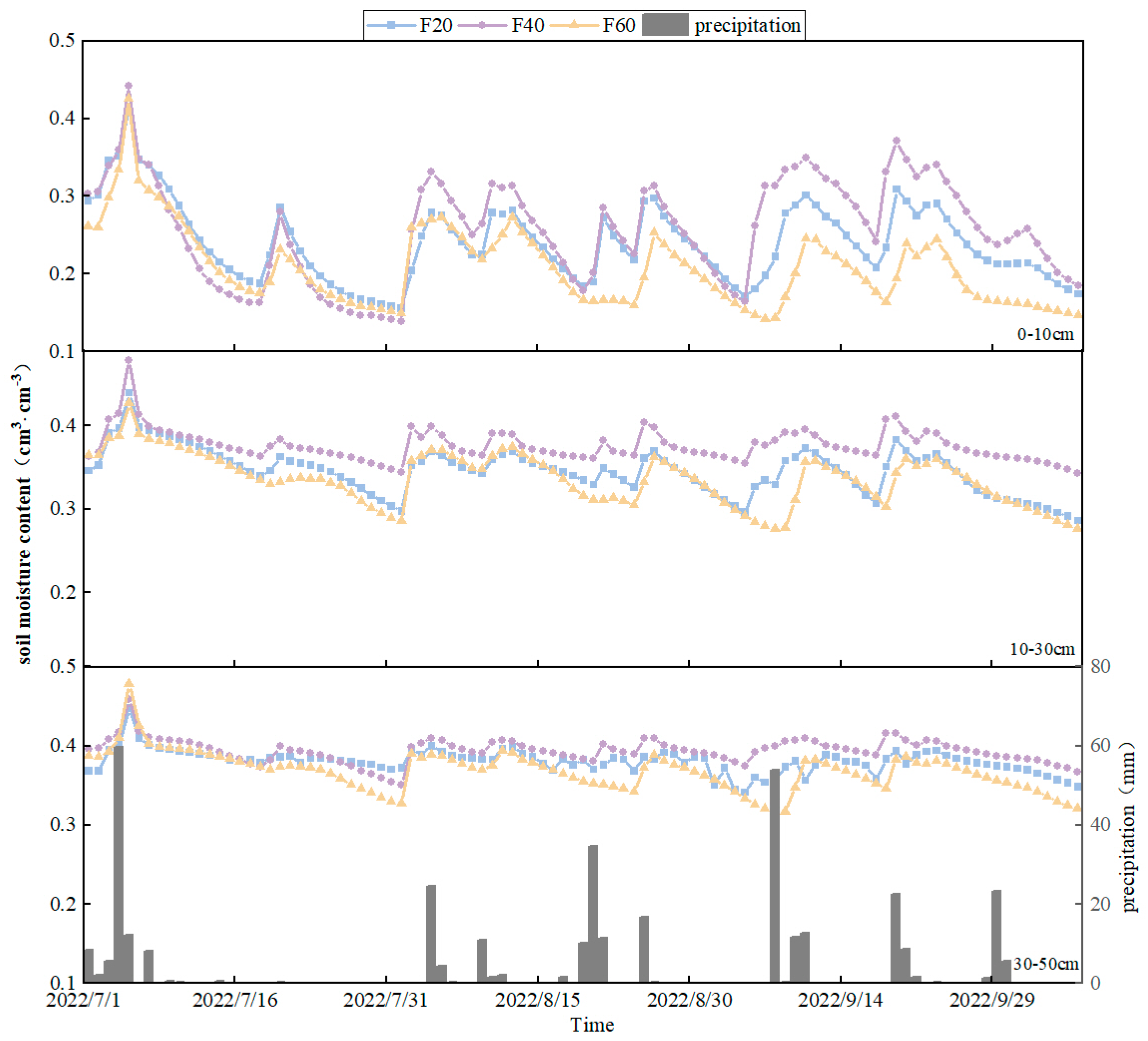
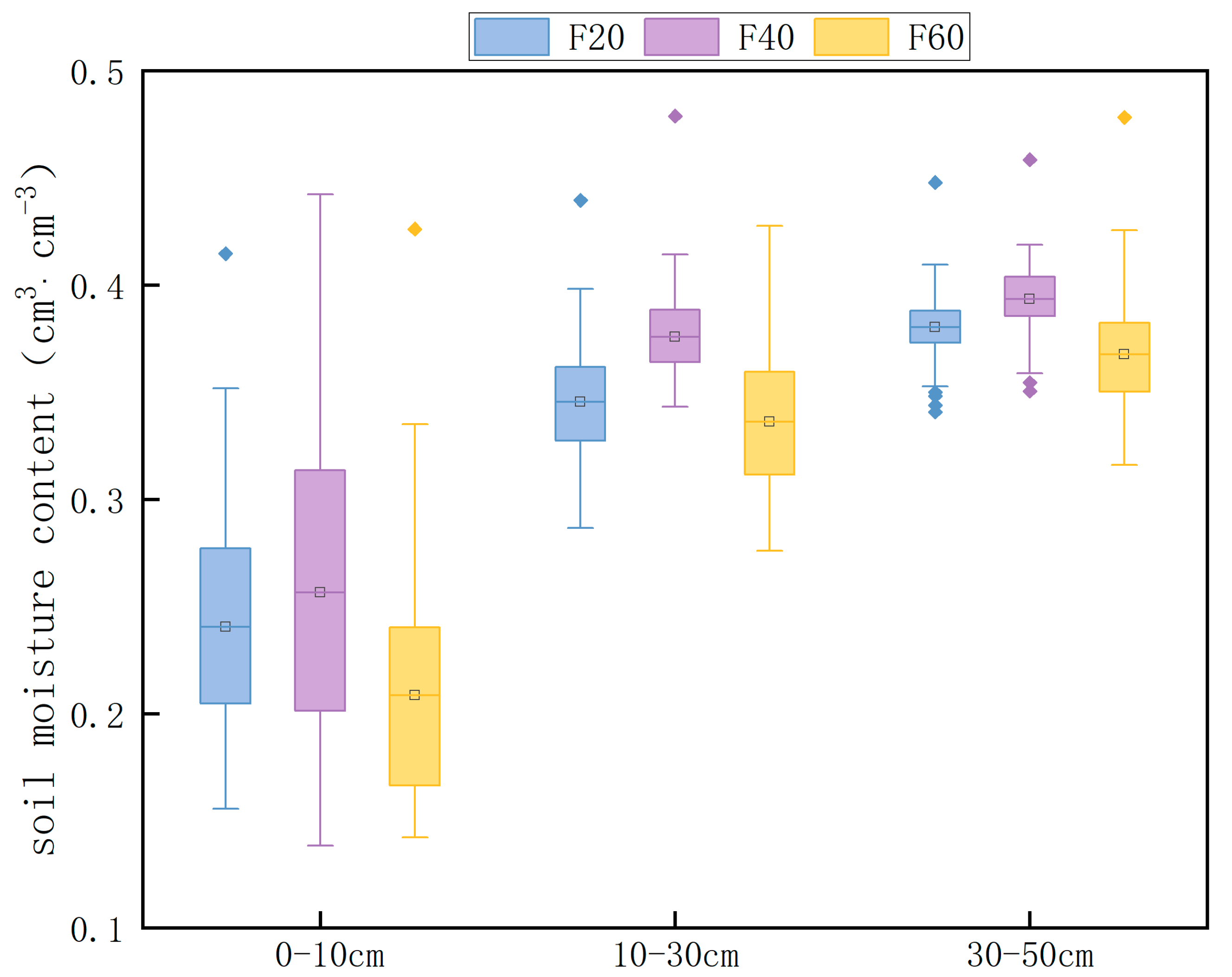
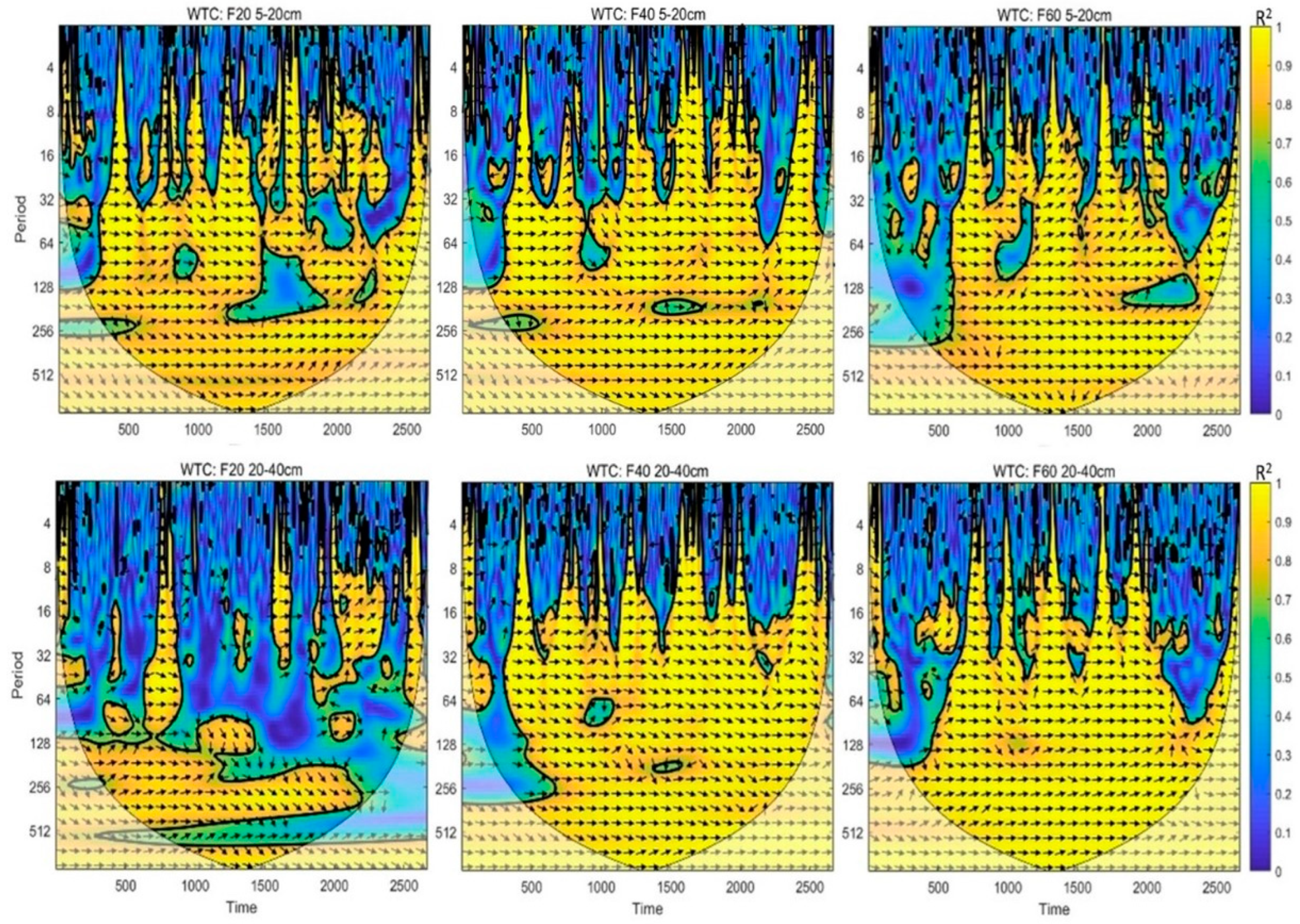
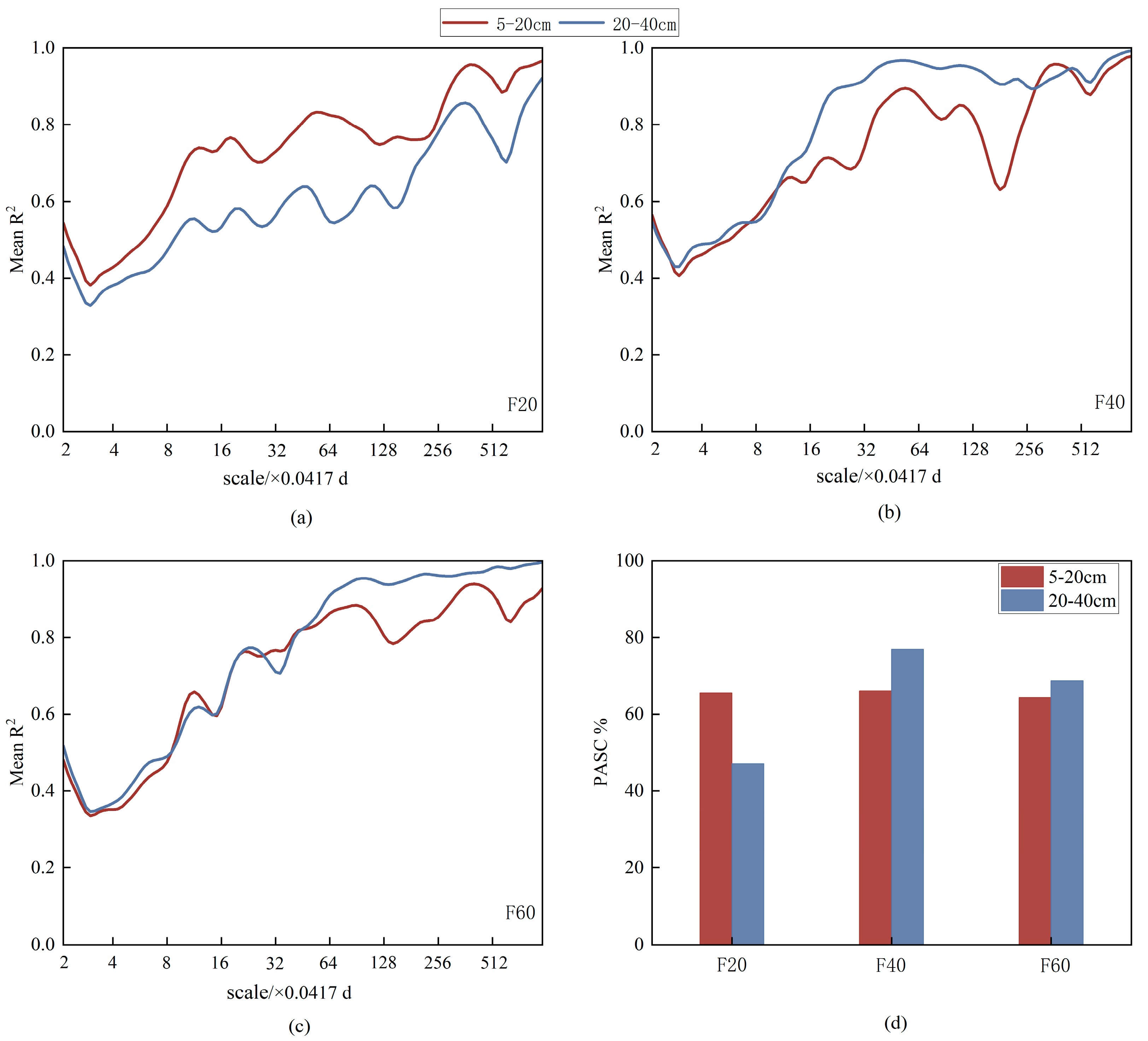
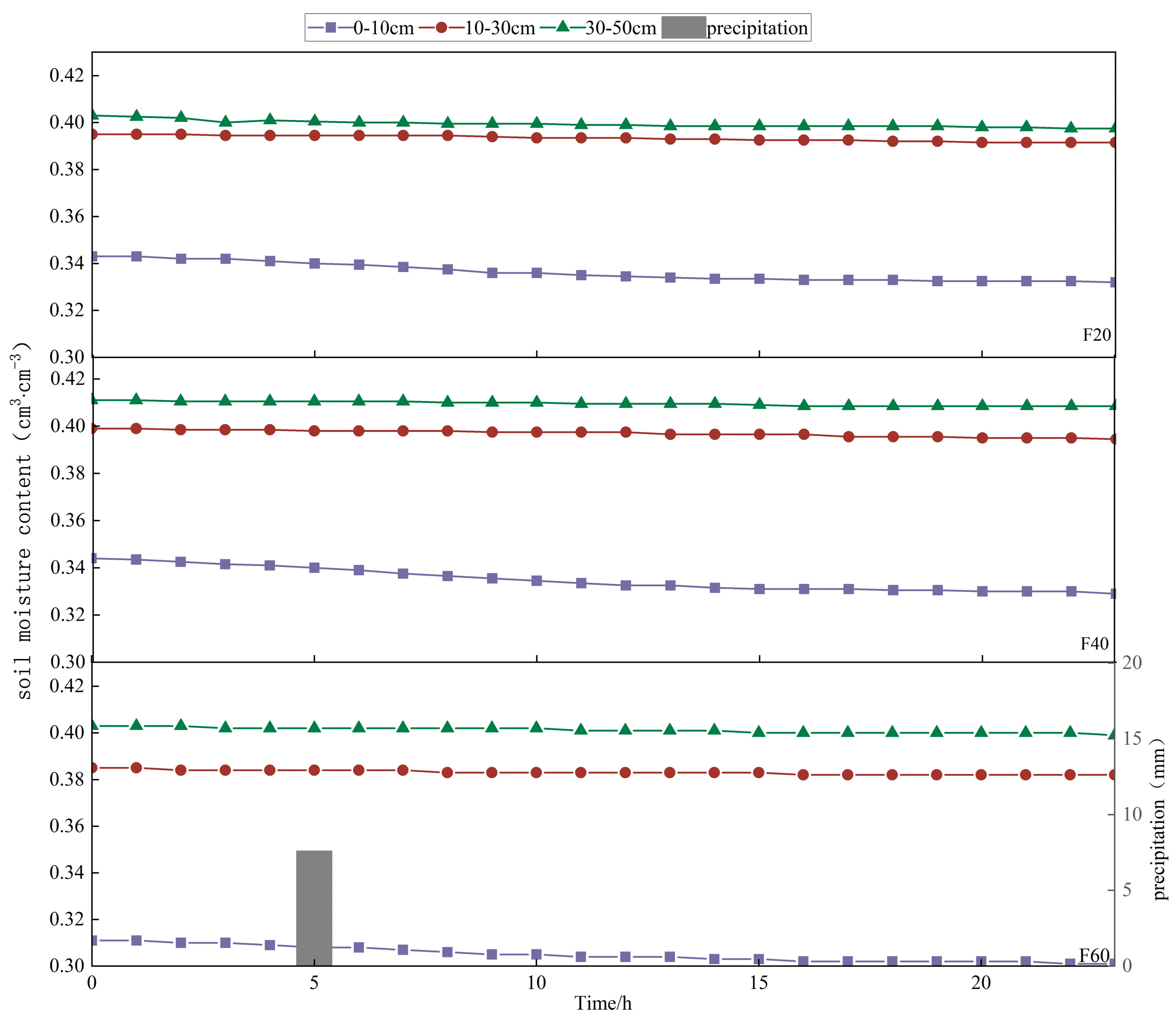
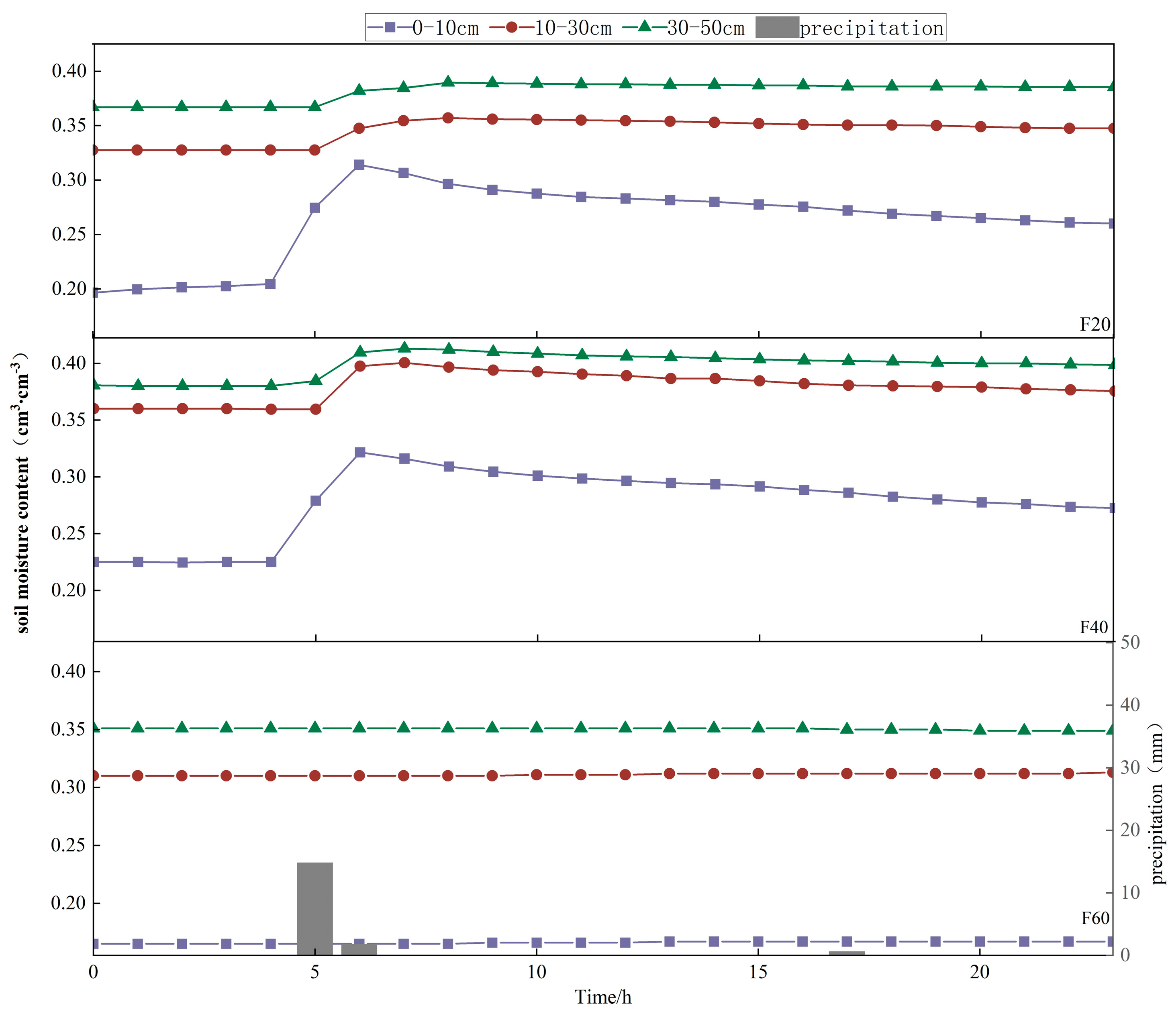

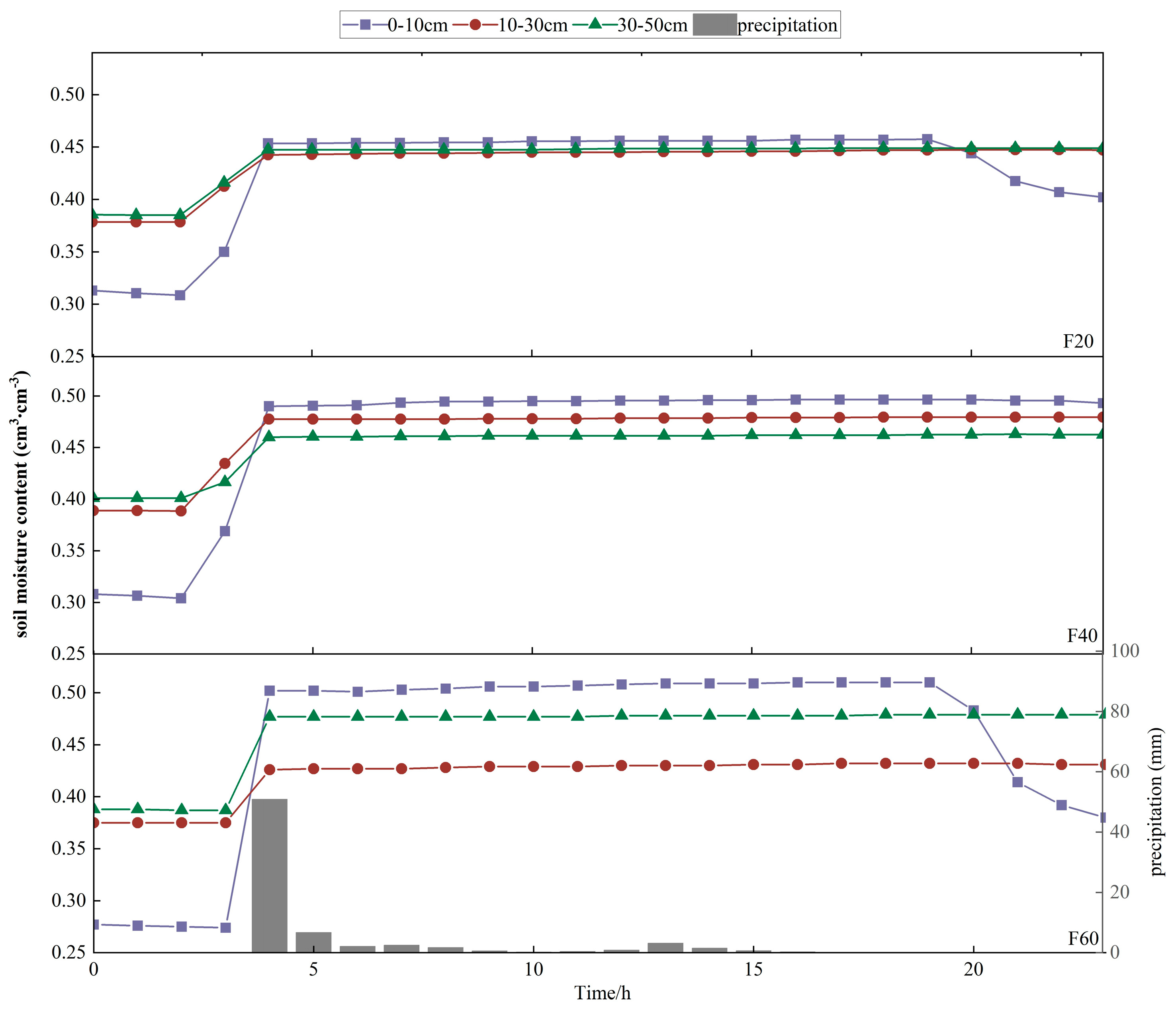
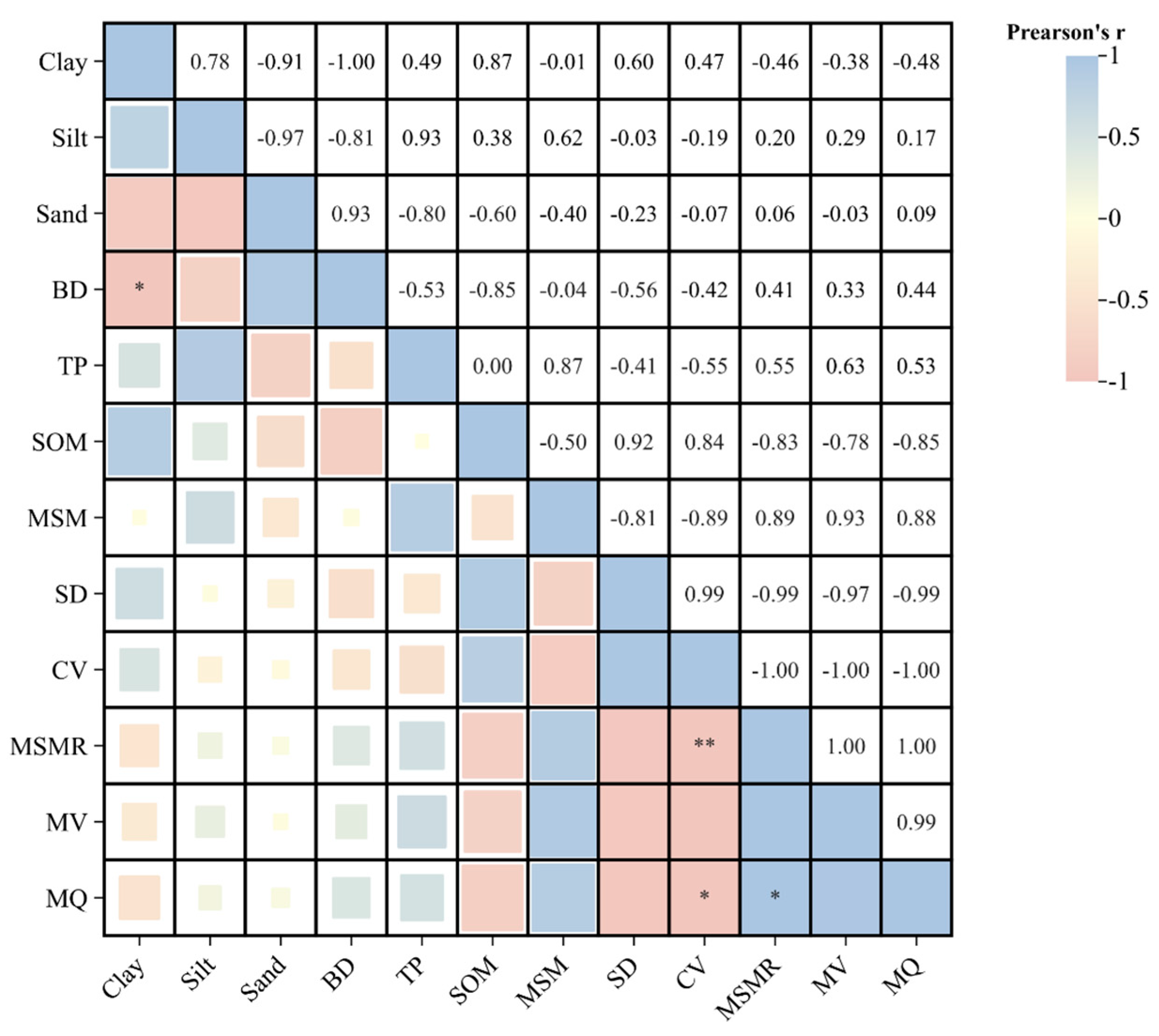
| Precipitation Type | Precipitation in 24 h (mm) | Events |
|---|---|---|
| Torrential rain | >50 | 2 |
| Heavy rain | 25–50 | 1 |
| Moderate rain | 10–25 | 10 |
| Light rain | <10 | 25 |
| Treatment | Depth (cm) | Clay (%) | Silt (%) | Sand (%) | BD (g∙cm−3) | TP (%) | SOM (g∙kg−1) |
|---|---|---|---|---|---|---|---|
| F20 | 0–10 | 20.78 ± 0.98 | 34.23 ± 1.78 | 44.99 ± 2.50 | 1.60 ± 0.02 | 43.01 ± 0.71 a | 15.29 ± 3.66 a |
| 10–30 | 27.21 ± 2.84 | 35.06 ± 3.96 | 37.69 ± 4.12 | 1.63 ± 0.05 | 41.88 ± 0.32 b | 13.17 ± 2.14 ab | |
| 30–50 | 36.78 ± 2.29 | 36.01 ± 1.12 | 27.21 ± 3.28 | 1.41 ± 0.08 | 49.83 ± 0.11 b | 7.38 ± 3.15 ab | |
| F40 | 0–10 | 31.08 ± 1.59 | 40.71 ± 1.34 | 28.17 ± 1.74 | 1.45 ± 0.01 | 48.38 ± 0.51 a | 14.22 ± 2.04 |
| 10–30 | 31.24 ± 3.05 | 43.93 ± 2.03 | 25.82 ± 2.89 | 1.63 ± 0.12 | 41.95 ± 0.17 b | 13.93 ± 2.22 | |
| 30–50 | 34.97 ± 3.31 | 47.43 ± 3.89 | 17.60 ± 5.67 | 1.40 ± 0.04 | 50.05 ± 0.23 a | 10.05 ± 5.10 | |
| F60 | 0–10 | 22.31 ± 3.09 | 37.40 ± 3.08 | 40.29 ± 1.81 | 1.59 ± 0.15 | 43.34 ± 5.38 a | 15.25 ± 2.28 |
| 10–30 | 30.96 ± 3.22 | 39.09 ± 4.41 | 28.96 ± 3.36 | 1.63 ± 0.07 | 41.98 ± 1.92 a | 13.70 ± 2.23 | |
| 30–50 | 44.47 ± 5.24 | 39.36 ± 4.21 | 16.17 ± 3.19 | 1.50 ± 0.16 | 49.49 ± 1.67 a | 11.73 ± 3.49 |
| Treatment Depth (cm) | F20 | F40 | F60 | ||||||
|---|---|---|---|---|---|---|---|---|---|
| 0–10 | 10–30 | 30–50 | 0–10 | 10–30 | 30–50 | 0–10 | 10–30 | 30–50 | |
| SD (%) | 5.42 | 3.04 | 1.73 | 6.83 | 1.98 | 1.59 | 5.39 | 3.79 | 3.08 |
| CV (%) | 22.78 | 8.90 | 4.57 | 26.05 | 5.26 | 4.03 | 27.06 | 11.60 | 8.55 |
| Precipitation Type | F20 | F40 | F60 | ||||||
|---|---|---|---|---|---|---|---|---|---|
(mm) | (mm∙h−1) | Q (%) | (mm) | (mm∙h−1) | Q (%) | (mm) | (mm∙h−1) | Q (%) | |
| Moderate rain | 16.20 | 1.16 | 36.99 | 18.60 | 1.43 | 42.46 | 0 | 0 | 0 |
| Heavy rain | 27.70 | 6.93 | 55.62 | 21.80 | 7.27 | 43.76 | 6.15 | 0.62 | 12.30 |
| Torrential rain | 28.20 | 4.70 | 39.44 | 34.50 | 5.75 | 48.25 | 35.70 | 4.45 | 49.93 |
| Mean | 24.03 | 4.26 | 44.02 | 24.97 | 4.82 | 45.36 | 13.95 | 1.68 | 20.74 |
Disclaimer/Publisher’s Note: The statements, opinions and data contained in all publications are solely those of the individual author(s) and contributor(s) and not of MDPI and/or the editor(s). MDPI and/or the editor(s) disclaim responsibility for any injury to people or property resulting from any ideas, methods, instructions or products referred to in the content. |
© 2024 by the authors. Licensee MDPI, Basel, Switzerland. This article is an open access article distributed under the terms and conditions of the Creative Commons Attribution (CC BY) license (https://creativecommons.org/licenses/by/4.0/).
Share and Cite
Zhang, Y.; Wang, S.; Gan, L.; Wei, B.; Zhang, J. Response of Soil Moisture to Precipitation at Different Smash-Ridging Tillage Depths in Typical Sugarcane Fields in Guangxi, China. Agronomy 2024, 14, 2576. https://doi.org/10.3390/agronomy14112576
Zhang Y, Wang S, Gan L, Wei B, Zhang J. Response of Soil Moisture to Precipitation at Different Smash-Ridging Tillage Depths in Typical Sugarcane Fields in Guangxi, China. Agronomy. 2024; 14(11):2576. https://doi.org/10.3390/agronomy14112576
Chicago/Turabian StyleZhang, Yu, Song Wang, Lei Gan, Benhui Wei, and Jinlian Zhang. 2024. "Response of Soil Moisture to Precipitation at Different Smash-Ridging Tillage Depths in Typical Sugarcane Fields in Guangxi, China" Agronomy 14, no. 11: 2576. https://doi.org/10.3390/agronomy14112576
APA StyleZhang, Y., Wang, S., Gan, L., Wei, B., & Zhang, J. (2024). Response of Soil Moisture to Precipitation at Different Smash-Ridging Tillage Depths in Typical Sugarcane Fields in Guangxi, China. Agronomy, 14(11), 2576. https://doi.org/10.3390/agronomy14112576







